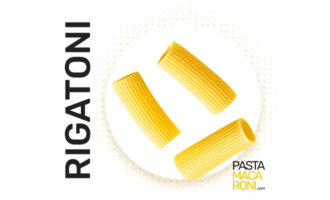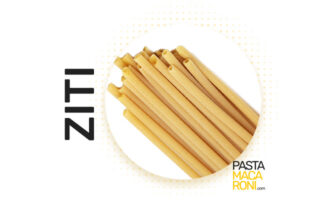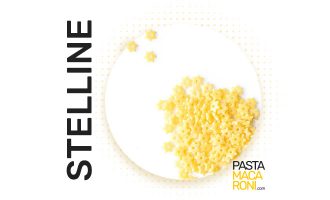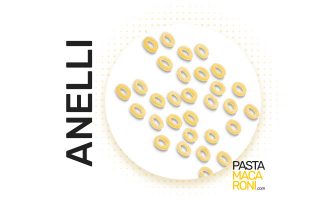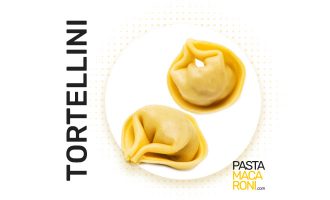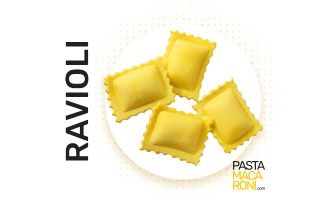The shape is a long and thin paste. The size is 1.8-2 mm in diameter.
Cooking time – 10-12 minutes (until ready).
Suitable for almost all sauces and dressings.
Briefly about Spaghetti pasta
Spaghetti pasta is a long, thin, cylindrical pasta made from wheat flour and water. They are popular all over the world and can be served hot or cold with a variety of sauces and toppings. Substitutes for spaghetti are linguini, fettuccine, and vermicelli. Spaghetti should be cooked in boiling water for 8-12 minutes and is a good source of complex carbohydrates, protein and fiber.
You have come to make delicious spaghetti?
What Spaghetti pasta looks like 📏 The shape of pasta

Spaghetti is a long and thin pasta with a circular section (from 1.8 mm to 2 mm in diameter).
Spaghetti pasta is a long, thin, cylindrical pasta that is made from wheat flour and water. It has a smooth, round surface and a firm texture. It is usually sold in long strands that are tied together and sold in boxes or bags.
What is Spaghetti | Description of the type of pasta and history
Spaghetti pasta is a type of pasta that originated in Italy and is now popular around the world. It is made from wheat flour and water and can come in many shapes and sizes. Spaghetti pasta is a versatile and easy-to-make dish that is a staple in many cuisines.
Spaghetti is the silent symbol of Italian cuisine and the most famous and popular kind of pasta worldwide. With its optimal thickness, spaghetti is considered a versatile type of pasta.
This format of long, dry pasta was originally made in southern Italy, in cities such as Naples, Genoa, and Liguria.
One of the first official references in the history of spaghetti was the name “spaghetto” recorded in the first dictionary of the Italian language, authored by Nicolo Tommaseo and Bernardo Bellini in 1819. Spaghetti” was a diminutive derivative of the word “spago”, which meant twine or string, and was described in the context: “Spaghetti soup is pasta as big as a small string and as long as sopracapellini”.
Features
Spaghetti is one of the most popular types of pasta in the world and is a staple dish in many cuisines. A versatile type of pasta that can be served hot or cold and combined with a wide variety of sauces and toppings.
Originally spaghetti was about 50 cm long. Nowadays, we cut it down to about 24 or 27 cm for comfortable cooking.

What does spaghetti go with | Serving and combining
Spaghetti pasta is often served with tomato sauces such as marinara or bolognese, but it can also be combined with cream-based sauces, pesto or meatballs. They can be served as a main course or as a side dish, and grated cheese, herbs or vegetables can be used as a garnish. Spaghetti pasta pairs well with various meats, seafood and vegetables, as well as delicate and light cream sauces based on cream, soft and hard cheeses, making it a versatile choice for any dish.
Spaghetti Pasta Substitutes
If you don’t have spaghetti pasta on hand or want to try something different, there are several other types of long pasta that can be substituted in the recipe. Some options include Linguine, Bavette, Fettuccine and Vermicelli. These types of pasta are similar in shape and texture to spaghetti and can be used in the same way.
How many types of spaghetti are there
There are many different types of spaghetti on the market. The most common type is regular spaghetti, which is made from durum wheat semolina and water. However, there are many other types of spaghetti, for example:
- Spaghetti alla chitarra — Square spaghetti made with eggs and flour. Named after a guitar-like device used to slice pasta;
- Spaghettini — A little thinner variant of spaghetti;
- Spaghettoni — A little thicker variation of spaghetti;
Also, each of these types, can include whole grain, gluten-free, vegetarian, chickpea and even legume pasta. Each type has its own unique flavor and texture, so it’s best to choose the right kind for your dish. With so many options available, it can be hard to decide what type of spaghetti pasta to use in your recipes. On this page, you can find information on the differences between the different types of pasta and tips on how to choose the right type for your dish.
For those looking for a healthier option, there are many gluten-free and vegetarian spaghetti. These types of spaghetti are made with ingredients such as quinoa, buckwheat and chickpea flour and are a great source of protein and fiber. In addition, many gluten-free and vegetarian spaghetti are fortified with vitamins and minerals, making them a great nutritional option.
🗒️ Calories and Nutritional Values
- Energy value 1503 kJ / 359 kcal
- 2 g fats
- Carbohydrates 70 g
- Proteins 14 g
Nutritional Factors (average per 100g) – Barilla Spaghetti n.5, 450 gr.
Spaghetti pasta is a good source of complex carbohydrates and contains moderate amounts of protein and fiber. It is low in fat and cholesterol-free. One serving of spaghetti pasta (about 2 ounces) contains about 200 calories and 40 grams of carbs. It is important to note that the nutritional value of spaghetti pasta can vary depending on how it is prepared and what it is combined with. For example, adding large amounts of cheese, butter or cream sauce can greatly increase the calories and fat content of the dish.
⏲️ Cooking time | How long to cook Spaghetti
- Until ready — 8-10 minutes.
- «Al dente» — 6-8 minutes.
Cooking time for spaghetti pasta depends on the size and thickness of the strands, as well as the desired level of firmness. In general, spaghetti pasta should be cooked in boiling water for 8-12 minutes, or until it is cooked to the desired level of firmness. It is important to check the pasta regularly while it is boiling and to drain the water immediately after cooking to prevent it from overcooking or forming a doughy mush.
🧑🍳 5 Best Simple Spaghetti Pasta Recipes
Spaghetti pasta is a classic Italian dish that is easy to make and can be served in many ways. Whether you’re looking for classic Italian spaghetti “Bolognese” or a more creative take on the traditional dish, there are many recipes for making delicious spaghetti pasta dishes. In this section, we take a look at a few simple spaghetti pasta recipes that are sure to satisfy your taste buds. From creamy carbonara to pesto spaghetti, these recipes are easy to make and perfect for a weekday dinner. If you’re looking for a vegetarian option, you’ll also find delicious meatless recipes.
Whether you want to make a quick weekday dinner or throw an Italian-style party, this versatile pasta is sure to please. Here we look at ways to make them perfectly and delicious recipes. So grab an apron and get ready to make some delicious spaghetti dishes!
Fresh and Easy Veggie Pasta — Vegetarian Spaghetti Recipe
Ingredients
- 12 ounces of spaghetti or other long pasta of choice
- 4 tablespoons olive oil
- 1 cup (140 grams) chopped onions
- 2 medium zucchini, chopped (1/2 pound)
- 2 medium yellow squash, chopped (1/2 pound)
- 3 garlic cloves, chopped
- 1/2 teaspoon dried oregano
- 1/4 teaspoon red pepper flakes
- 2 tablespoons tomato paste
- 1 can of whole peeled tomatoes
- 5 cups (1/2 pound) spinach leaves
- Handful of fresh basil leaves
- Salt and freshly ground black pepper
- Parmesan cheese
A quick and easy vegetable spaghetti that’s so good, you won’t even notice it’s full of nutritious vegetables. Vegetarian spaghetti dishes are a great way to incorporate lots of plant-based foods and diversify your diet. Plus, they’re just as easy to make as meat dishes. So why not try a delicious and nutritious spaghetti dish tonight?
Vegetarian spaghetti pasta dishes are a great way to enjoy all the delicious flavors of traditional Italian cuisine without meat. There are many ways to make delicious and hearty vegetarian spaghetti pasta dishes. For a heartier dish, add protein-rich ingredients such as chickpeas, lentils or beans.
How to cook traditional spaghetti alla carbonara – Easy and quick recipe
Ingredients
- 300 grams of Spaghetti
- 200 grams of Pecorino Romano cheese
- 300 grams of guanchiale
- 4 eggs 3 egg yolks + 1 whole egg
- Black pepper
Vincenzo’s Plate’s version of an authentic Roman dish. Spaghetti alla carbonara is a traditional Italian recipe, and every time you make this dish, it gets better and better. Crispy and tender in the middle, guanchiale is mixed with spaghetti and homemade peppered carbonara sauce with a touch of pecorino.
Spaghetti with Chicken Alfredo recipe – Homemade Italian recipe
Ingredients:
- Spaghetti 300 g.
- Chicken 200g
- Mushrooms 100g
- Onions 1/2 large
- Garlic 2 cloves
- Chicken broth 1 cup
- Heavy cream 1 cup
- Cream cheese 1/2 cup
- Parmesan cheese 1/2 cup
- Salt 1 tsp.
- Black pepper 1 tsp.
- Coconut oil 2 tbsp.
- Parsley
- Chili flakes 1 tsp.
- Paprika 1/2 tsp.
Spaghetti with Alfredo White Cream Sauce and Chicken is a complete meal in 30 minutes. This is a very flavorful and hearty pasta recipe that can be made for lunch or dinner.
Simple spaghetti with pesto – delicious basil and pistachio pasta
Ingredients:
- 3 cups fresh basil leaves
- 2 cups fresh parsley leaves
- 1 cup toasted unsalted pistachios
- 8 garlic cloves
- 1 teaspoon salt
- 1 cup plus 2 tablespoons extra virgin olive oil
- 1 pound of spaghetti or other long pasta
- ½ cup grated grana padano or parmesan
- If desired, you can add a couple tablespoons of pine nuts to the pesto
How to make spaghetti bolognese – Quick and easy pasta recipe
Ingredients for spaghetti bolognese:
- 1 tbsp. olive oil
- 1 onion, peeled and finely diced
- 2 garlic cloves, peeled and chopped
- 1 pound (450 g) ground beef.
- 1 carrot, peeled and finely diced
- 3 mushrooms, finely diced (optional)
- ½ cup (120 ml) red wine
- 3 tablespoons tomato puree
- 1 tsp. dried oregano
- ½ tsp. dried thyme
- 1 tbsp. Worcestershire sauce (optional)
- 1 cube beef broth, crumbled
- 28 oz (2 x 400 g) canned chopped tomatoes
- ½ tbsp. light brown sugar
- ½ tsp. salt
- ½ tsp. black pepper
- 10 oz (300 g) spaghetti
This spaghetti bolognese recipe is great for making a hearty and satisfying weeknight dinner. It takes only 30 minutes from start to finish. Simple ingredients and lots of meaty-tomato flavor.
Spaghetti pasta is one of the staples of traditional Italian cuisine, and the recipes and traditions associated with it have been passed down from generation to generation. Spaghetti is the most popular form of pasta in the world and is a versatile ingredient that can be used in a wide variety of dishes, from classic Italian dishes like spaghetti bolognese and carbonara, to more creative dishes like lasagna with vegetarian toppings and zucchini noodles.
It’s also worth noting that spaghetti pasta is incredibly easy to make at home, because all you need is a pasta machine, some durum wheat semolina and water. It’s also a great way to get creative in the kitchen and experience the flavors of Italian cuisine. So why not try and experience a taste of the Italian tradition of spaghetti pasta?
Pairing wine with spaghetti pasta dishes
When it comes to how to pair wine with spaghetti pasta dishes, there are several factors to consider. The first is the type of pasta dish being served. For a classic Italian spaghetti dish such as bolognese or carbonara, a full-bodied red wine would be the perfect companion. For lighter dishes, such as spaghetti with seafood, a white wine such as Pinot Grigio or Sauvignon Blanc is recommended. In addition, the type of sauce you use to make your pasta dish can also affect your choice of wine. A fruity red wine is ideal for a tomato sauce, and a white or rose wine for a creamy sauce. Regardless of your preference, you have plenty of options when it comes to choosing wine to go with your spaghetti dish.
FAQ about Spaghetti pasta | All you have to ask
Everything you wanted to ask about spaghetti. If you don’t find the answer to your question, leave it in the comments.
-
Is spaghetti and pasta the same thing?
Spaghetti is called pasta because it is a type of pasta. Pasta is a general term for various wheat-based foods that are made into long, thin strands or shapes, such as Bavette, Capellini and Linguine. Spaghetti is a special kind of pasta that is long and thin and has a cylindrical or slightly flattened shape. The word “pasta” comes from the Italian word “pasta,” which means “dough.”
-
What is spaghetti pasta made of?
Spaghetti pasta is made from wheat flour and water. They are made by mixing the two ingredients to make dough, which is then rolled and cut into thin strands. Some types of spaghetti may contain other ingredients such as eggs, rye flour, spinach, tomatoes, cuttlefish ink and other additives to give the pasta a different flavor, color or texture.
-
What is spaghetti pasta used for?
Spaghetti pasta is used in a wide variety of dishes and is a staple in many cuisines around the world. It can be served hot or cold and combined with a wide variety of spaghetti sauces and toppings. Spaghetti is often used as a main dish, but it can also be served as a side dish or used in soups and casseroles.
-
Spaghetti pasta is healthy or unhealthy?
Spaghetti pasta can be part of a healthy diet if eaten in moderation and combined with nutritious toppings and sauces. It is a good source of complex carbohydrates and contains moderate amounts of protein and fiber. It helps regulate digestion, lower cholesterol, and support heart health. In addition, spaghetti pasta is a great source of protein – each serving contains 8 grams of protein. This makes it a great choice for vegetarians and vegans who want their daily protein allowance.
However, it is important to be mindful of portion sizes and choose healthy toppings, as adding large amounts of cheese or high-fat sauce can greatly increase the calories and fat content of a dish. Like any other food, spaghetti pasta is important to eat as part of a balanced diet that includes a variety of nutrients from different food groups. -
Can noodles be used instead of spaghetti?
In some recipes, noodles can be used instead of spaghetti, although the texture and taste may be slightly different. Noodles are a type of pasta that is made from wheat flour and water, but they are usually shaped like flat ribbon-like strands rather than cylindrical shapes. Some types of noodles, such as udon and soba, are made from different kinds of flour, such as buckwheat or rice. If you want to use noodles instead of spaghetti, it is best to choose a type of noodle that is similar in shape and size to spaghetti, such as Linguini, Bavette or Fettuccine.
-
Which is healthier – noodles or spaghetti?
Both noodles and spaghetti can be part of a healthy diet if eaten in moderation and combined with nutritious toppings and sauces. Both types of pasta are made from wheat flour and water and are a good source of complex carbohydrates. However, the nutritional value of noodles and spaghetti can vary depending on the type and brand of pasta and how they are prepared and served. It is important to choose a variety of nutritious foods from different food groups as part of a balanced diet.
-
Does spaghetti need oil?
Oil is not necessary when cooking spaghetti. If you want to add oil to your spaghetti dish, you can drop a small amount of olive oil into the cooked pasta before serving to keep it from sticking. Watch the amount of oil you use, as it can add calories and fat to a dish.
-
What can I eat with spaghetti? What kind of sauce is spaghetti used for?
Spaghetti is a versatile pasta that can be combined with a wide variety of sauces and toppings. Popular choices include tomato-based sauces recipe such as marinara or bolognese, as well as cream-based sauces, pesto or meatballs. Spaghetti can also be garnished with grated cheese, herbs or vegetables. In addition to the sauce, spaghetti can be combined with a variety of meats, seafood and vegetables to create a hearty and flavorful dish.
-
Why is spaghetti so popular?
Spaghetti is popular for several reasons. It is a staple dish in many cuisines around the world. This pasta is easy to find, cheap, and lasts a long time in dried form. Spaghetti is also versatile and can be combined with a wide range of sauces and toppings, making it suitable for a variety of tastes and preferences. In addition, spaghetti is easy to prepare and quick to cook, making it a convenient choice for busy people and families. The widespread popularity of spaghetti is due in part to its general availability and the fact that it is a familiar and favorite food for many people.
-
What is the most popular spaghetti dish?
There are many popular spaghetti dishes, and the most popular can vary depending on the area and personal preference. But usually, the most popular spaghetti dishes are:
1) spaghetti bolognese, which is made with a meat sauce and often served with grated cheese;
2) spaghetti carbonara, which is made with eggs, bacon and cheese;
3) spaghetti aglio e olio, which is made with garlic, olive oil and chili flakes. -
What to add to spaghetti to make it taste better?
There are many ways to give spaghetti a better flavor to make it tastier:
– You can add herbs like basil or oregano to the sauce;
– Add spices to the sauce, such as red pepper flakes or ground black pepper;
– Add grated parmesan cheese or nuts to the finished dish;
– You can also try combining spaghetti with a flavorful sauce, such as meat or pesto;
– Add vegetables or mushrooms to the dish, such as diced tomatoes or roasted champignons. -
Which country eats the most spaghetti?

Spaghetti is a popular dish in many parts of the world. Spaghetti is a staple dish in Italy, where it is thought to have originated, and it is also popular in other countries in Europe and around the world. In the United States, spaghetti is a popular dish enjoyed by people of all ages and considered a comforting and common food.
According to Statista in October 2022, 55% of U.S. respondents say they eat pasta regularly. And in Italy, 81% of respondents regularly include pasta in their daily menu. Almost as popular is the food in France, where 78% of respondents regularly include it on their shopping list. In India, only 30% of respondents said they eat pasta regularly, while in China the figure is just 16%. -
In what country was spaghetti invented?
Spaghetti is believed to have originated in Italy, although the exact origins are unclear. There are many legends and stories about the origins of spaghetti, but it is believed that it was first cooked in Italy in the 15th century. One of the first official mentions of spaghetti in history was the name “spaghetto,” recorded in the first dictionary of the Italian language, authored by Nicolo Tommaseo and Bernardo Bellini in 1819. Spaghetti became popular in Italy and other parts of Europe in the 19th century and has since become a popular dish around the world.
-
Does the spaghetti need to be broken in half before cooking?
It is not necessary to break the spaghetti in half before cooking. Spaghetti is cooked in long strands. If you have difficulty placing the spaghetti in the pot, you can gently bend it into a more compact shape and press it with a fork or spoon to gently twist it onto the bottom of the pot while it’s cooking.
-
Do I need to rinse the spaghetti after cooking?
Rinsing spaghetti after cooking is generally not recommended. Rinsing the pasta can remove some of the starch that helps thicken the sauce and make the pasta less flavorful. Also, rinsing pasta can cause it to stick together, become cold, and lose its texture.
Rinse pasta in cold water only in the following situations:
1) If the pasta is being used to make a salad. This will stop them from cooking any further.
2) When the pasta is boiled and the sauce is not ready. There is a risk that they will boil over. In this case, it is better to rinse with cold water and lose the starch than end up with overcooked pasta. -
Are there gluten-free alternatives to spaghetti pasta?
When it comes to gluten-free eating, many people think they have to give up their favorite spaghetti dishes. But that’s not the case! There are many gluten-free spaghetti alternatives on the market today, including Barilla Chickpea Spaghetti Pasta. You can also find pasta made from buckwheat, rice, rye, rice, quinoa, cassava, corn, almonds and legumes. This kind of spaghetti is as easy to make as regular pasta and has an interesting flavor and texture. In addition, they contain all the same health benefits as regular pasta, such as being a good source of protein, fiber and B vitamins. So if you’re looking for a gluten-free alternative to spaghetti, be sure to try this kind of pasta.
-
How to store cooked spaghetti pasta?
Once the spaghetti is cooked, it’s important to store it properly so it can be enjoyed later. To store spaghetti, first make sure it has cooled completely. Then transfer the spaghetti to an airtight container and store it in the refrigerator for up to five days, less is better. If you need to keep spaghetti longer, you can freeze it. To freeze spaghetti, spread it out on a baking sheet and put it in the freezer for several hours. Once frozen, put them in a freezer-safe bag or container and store in the freezer for up to 3 months.
How to boil Spaghetti pasta
Cooking spaghetti pasta is relatively simple and doesn’t require much skill.
- Fill a large saucepan with water and bring it to a boil over high heat.
Once the water is boiling, add salt to the pot. The amount of salt depends on your personal preference, but a good rule of thumb is to add about 1 teaspoon of salt without a spoonful for every quart of water (1.1 liters).
- Add the spaghetti to a pot of boiling water.
Stir the noodles occasionally to keep them from sticking together. Check the pasta for readiness after about 8 minutes. To check the spaghetti for readiness, fish out the pasta with a fork and take a bite of it. They should be cooked but still firm to the taste (this is called “al dente”). If the pasta is still too hard, continue to cook it and check every minute until it is ready.
- When the spaghetti is cooked to the desired degree of doneness, drain in a colander
- Serve the noodles hot, with sauce, cheese or other toppings of your choice. Bon appetit!
Basic simple preparation of spaghetti pasta or any other pasta.
When it comes to cooking spaghetti, it’s important to pay attention to the instructions on the package. For example, the cooking time for pasta depends on its type and thickness. As a rule of thumb, thin pasta, such as angel hair, should be boiled for about 3 minutes and thicker pasta, such as spaghetti, for about 8 minutes. If you’re making sauce, it’s also important to remember to save ¼ cup of pasta water before draining. This starchy liquid helps create a creamy sauce when combined with the sauce ingredients.
With the right type of pasta and cooking instructions, you can create a delicious spaghetti dish that is sure to be a hit!

